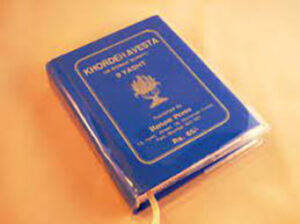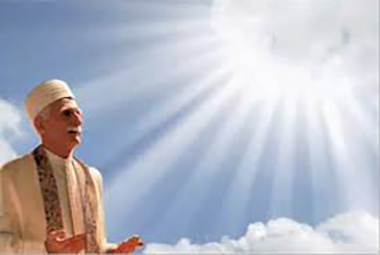 Recently a Parsi Times reader, whose mother has been ailing, called to inquire about ‘Afshun-e-Shah Faridoon’. He also wanted to know the prayers which he and his mother could recite, to bring about healing.
Recently a Parsi Times reader, whose mother has been ailing, called to inquire about ‘Afshun-e-Shah Faridoon’. He also wanted to know the prayers which he and his mother could recite, to bring about healing.
The Persian term, ‘Afshun’ or ‘Afsoon’, means a charm or a spell, which we more commonly refer to as Nirang, and Afshun-e-Shah Faridoon means the Nirang (a potent capsule prayer) believed to be handed down to us from the time of the Saintly King Faridoon of ancient Iran. It is considered very efficacious to remember the name of Shah Faridoon and invoke his pious Fravashi for spiritual assistance during prolonged illness, or whenever one feels afflicted by negativity. His Fravashi may also be invoked for spiritual assistance in controlling personal weaknesses such as the demon of wrath, greed, envy, etc.
Shah Faridoon: The kings of ancient Iran, especially during the Peshdad and Kayan dynasties, were both – spiritual and temporal leaders. After a long golden period under Shah Jamsheed, ancient Iran came under the rule of the evil Zohak or Azhi dahaka – a tyrant who unleashed an era of terror and oppression. He cruelly assassinated Shah Jamsheed and ordered human sacrifices. In the Avesta, Zohak is called Baevare-aspa (possessing the strength of ten thousand horses). He was the living embodiment of evil and the ten vices that afflict humanity.
 Faridoon (one possessing the wisdom of the eighth sky) was born to Athwiyan and Franak, during these troubled times. When evil Zohak murdered Athwiyan, Faridoon’s mother Franak took the little boy to a secluded place in the Alburz Mountains and entrusted the child in the care of Purmayaah, the spiritual cow, who nursed the child for three years. In the meantime, astrologers began to predict that a young lad named Faridoon would soon slay the evil Zohak.
Faridoon (one possessing the wisdom of the eighth sky) was born to Athwiyan and Franak, during these troubled times. When evil Zohak murdered Athwiyan, Faridoon’s mother Franak took the little boy to a secluded place in the Alburz Mountains and entrusted the child in the care of Purmayaah, the spiritual cow, who nursed the child for three years. In the meantime, astrologers began to predict that a young lad named Faridoon would soon slay the evil Zohak.
The first to rise in rebellion against Zohak was a blacksmith named Kawa. He made a Battle Standard (flag) out of his leather apron and collected an army under Drafshi-i-Kawayani (the flag of Kawa). Kawa sought out Faridoon and encouraged him to liberate Iran from the yoke of Zohak’s evil rule. Faridoon, with the aid of Sarosh Yazata, was successful in overthrowing Zohak. According to legend, Faridoon has enchained Zohak to Mount Damavand – the highest peak in the Alburz Mountain range, in Northern Iran.
Master Healer: Shah Faridoon is also recognised in Zoroastrian tradition as a Master Healer. He is said to have known all sorts of holy incantations (Nirang), with which he could change his form at will, as also heal various afflictions. Even today, several Nirang which we pray, are ascribed to Shah Faridoon.
Shah Faridoon had been blessed by Sarosh Yazata with the power to neutralize all forms of evil, whether in the form of disease, human vices or negative energies. In the Fravardin Yasht we invoke his righteous Fravashi in order to withstand various diseases: “Thrnotnonahe Athuynnoish ashaono Iravashim yazamaide.” We also pray in the Vanant Yasht: “Baeshaza goafringan bad. Name Ahura Mazda pa name niv khoreh Faridoon Faridoon Athavyan.” (May there be health and fame – through the name of Ahura Mazda and through the name and the power and glory of Faridoon the son of Athavyan).
Health Is Our True Wealth: Good health is our true wealth. Given a choice between health and wealth, choose health because if you have good health, you can earn wealth and more importantly, enjoy your wealth. What’s the point in having wealth but no health to enjoy it?
Several studies have indicated that prayer can positively impact health. It can provide one with a sense of calm, control, and connection. Praying for the well-being of others, even those who may have harmed us – can reduce anger and aggression. Along with gratitude, prayer is one of the most powerful tools to create a calm inner space. In a world torn by rising intolerance, prayer is a powerful transformative tool.
Zoroastrian Healing Prayers: The Ardibehesht Yasht is one of the best prayers for healing all kinds of physical ailments. There is also an old healing tradition of ‘Ardibehesht ni Picchi’, where a priest or even a lay person, after a bath and performing the farazyat (obligatory) prayers, recites the Ardibehesht Yasht, running a clean white handkerchief or a clean muslin cloth from head to toe of the ailing person. It is a tried and tested Zoroastrian form of healing, with a high degree of success.
In the Ardibehesht Yasht, we pray, “Ādim framraomi Ashem Vahishtem; yezī framraomi Ashem Vahishtem, āat anyaēsham Ameshanām Spentanām hvāyaonem; yim pāiti Mazdāo humatāish, yim pāiti Mazdāo hūkhtāish, yim pāiti Mazdāo hvarshtāish. Garō-nmānem Ahurahe hvāyaonem. Garō-nmānem nereyō asti ashāvaoyō. Naēchish dravatām ayene paitish garō-nmanem, ravohu ashāyonem chithrem Ahurem Mazdām.”
Translated, it means, “I like him (i.e., Ardibehesht); when I like Ardibehesht, then (he) of (all) other Ameshāspands (becomes) a helper, whom (the Creator) Ahura Mazda nourishes with good thoughts, and good words, and good actions. Garothmān (Paradise) is Ahura Mazda’s own abode, meant for righteous persons.” The essence of this verse is that only a righteous person can be in the abode or presence of Ahura Mazda.
The Ardibehesht Yasht also refers to five types of healers: “Ashō-baēshazō, dātō-baeshazō, karetō-baēshazō, urvarōbaēshazō, mānthrō-baēshazō; baēshazanām baēshazyōtemō yat mānthrem-spentem-baēshazyō; yō narsh ashaonō hacha uruthwān baēshzyāt, aeshō zī asti baēshazanām baēshazyōtemō” or “One who heals by means of purification rites or through his own Ashoi or piety (Ashō-baēshazō); one who cures (social ills) by law and justice (dātō-baeshazō); one who heals with the knife like a surgeon (karetō-baēshazō); one who restores health by means of herbs and vegetation (urvarōbaēshazō); and one who heals by means of reciting the mānthra or prayers (mānthrō-baēshazō).” The Yasht affirms: “best among healers is the one who heals reciting the mānthra.”
The Nirang Of Ardibehesht: The Ardibehesht Nirang is a very powerful capsule prayer which should be recited three times after the recitation of Ardibehesht Yasht. “Dādāre jehādār tavānā O dānā, O parvartār O āfarīdegār, O kerfehgar, O avakhshīdār. Ahereman hīch, nādān, O natavānad ba hīch chīz nashahed. Ahura Mazda dādārī, ahereman marochīnīdārī. Dādār pāk, ahereman nāpāk; ahereman khāk shavad, ahereman dūr shavad, ahereman dafe shavad, ahereman shekasteh shavad, ahereman halāk shavad. Avval dīn Zarathushtī pāk; Ahura Mazda buland kavī, beh, awazūnī.” Which means, “The Creator, the keeper of the world, (is) omnipotent and omniscient, and the Nourisher of all, and the producer, and the Doer of meritorious deeds and overseer. Ahriman is nothing whatsoever (and is) ignorant, and cannot do anything. Hormazd (is) the Creator (and) Ahriman the destroyer. The Creator (is) Holy and Ahriman (is) wicked. May Ahriman perish, may Ahriman be far away, may Ahriman be vanished, may Ahriman be defeated and may Ahriman be overcome. The foremost Religion (is the) pure Zoroastrian (Religion); Hormazd (is) Exalted, Powerful, Good (and) the Increaser.”
Airyaman Isho: The Ardibehesht Yasht also refers to the prayer of Airyaman Isho, which is actually Yasna 54. It is very efficacious and powerful and should be prayed just before the chanting of Ardibehest Yasht. Airyaman Yazad is a co-worker of Ardibehesht Ameshaspand, and therefore, it is considered very meritorious and beneficial to recite this manthra before the Ardibehesht Yasht. Yasna 54.1 is recited 4 times. It has the power to drive away diseases, physical, mental as well as spiritual. Part of it is composed in the Gathic dialect and it is affirmed that this specific Yasna 54 will be recited at the time of the future restoration of the world.
- Celebrating Women And Equality - 8 March2025
- How The Greeks Viewed Ancient Persians - 1 March2025
- Moon And Moods - 22 February2025
